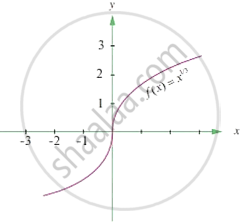Advertisements
Advertisements
Question
Discuss the Continuity of the F(X) at the Indicated Points : F(X) = | X − 1 | + | X + 1 | at X = −1, 1.
Solution
Given : \[f\left( x \right) = \left| x - 1 \right| + \left| x + 1 \right|\]
We have
(LHL at x = −1) = \[\lim_{x \to - 1^-} f\left( x \right) = \lim_{h \to 0} f\left( - 1 - h \right)\]
Now,
(LHL at x = 1) = \[\lim_{x \to 1^-} f\left( x \right) = \lim_{h \to 0} f\left( 1 - h \right) = \lim_{h \to 0} \left( \left| 1 - h - 1 \right| + \left| 1 - h + 1 \right| \right) = 0 + 2 = 2\]
(RHL at x =1) = \[\lim_{x \to 1^+} f\left( x \right) = \lim_{h \to 0} f\left( 1 + h \right) = \lim_{h \to 0} \left( \left| 1 + h - 1 \right| + \left| 1 + h + 1 \right| \right) = 0 + 2 = 2\]
Also,
APPEARS IN
RELATED QUESTIONS
Show that the function `f(x)=|x-3|,x in R` is continuous but not differentiable at x = 3.
Find all points of discontinuity of f, where f is defined by `f(x) = {(|x|/x , if x != 0),(0, if x = 0):}`
Find all points of discontinuity of f, where f is defined by `f (x) = {(x^10 - 1, if x<=1),(x^2, if x > 1):}`
Is the function defined by `f(x) = {(x+5, if x <= 1),(x -5, if x > 1):}` a continuous function?
Show that the function defined by g(x) = x = [x] is discontinuous at all integral points. Here [x] denotes the greatest integer less than or equal to x.
Find the points of discontinuity of f, where `f (x) = {(sinx/x, if x<0),(x + 1, if x >= 0):}`
Determine if f defined by `f(x) = {(x^2 sin 1/x, "," if x != 0),(0, "," if x = 0):}` is a continuous function?
Find all the points of discontinuity of f defined by `f(x) = |x| - |x + 1|`.
Determine the value of the constant 'k' so that function f(x) `{((kx)/|x|, ","if x < 0),(3"," , if x >= 0):}` is continuous at x = 0
Show that the function f(x) = `{(x^2, x<=1),(1/2, x>1):}` is continuous at x = 1 but not differentiable.
Test the continuity of the function on f(x) at the origin:
\[f\left( x \right) = \begin{cases}\frac{x}{\left| x \right|}, & x \neq 0 \\ 1 , & x = 0\end{cases}\]
Prove that the function
Find the relationship between 'a' and 'b' so that the function 'f' defined by
Find the points of discontinuity, if any, of the following functions:
Find the points of discontinuity, if any, of the following functions: \[f\left( x \right) = \begin{cases}x^{10} - 1, & \text{ if } x \leq 1 \\ x^2 , & \text{ if } x > 1\end{cases}\]
In the following, determine the value of constant involved in the definition so that the given function is continuou:
The function f (x) = tan x is discontinuous on the set
Find the point of discontinuity, if any, of the following function: \[f\left( x \right) = \begin{cases}\sin x - \cos x , & \text{ if } x \neq 0 \\ - 1 , & \text{ if } x = 0\end{cases}\]
Show that the function `f(x) = |x-4|, x ∈ R` is continuous, but not diffrent at x = 4.
Prove that `1/2 "cos"^(-1) ((1-"x")/(1+"x")) = "tan"^-1 sqrt"x"`
Find all points of discontinuity of the function f(t) = `1/("t"^2 + "t" - 2)`, where t = `1/(x - 1)`
`lim_("x" -> pi/2)` [sinx] is equal to ____________.
The number of discontinuous functions y(x) on [-2, 2] satisfying x2 + y2 = 4 is ____________.
Let f (x) `= (1 - "tan x")/(4"x" - pi), "x" ne pi/4, "x" in (0, pi/2).` If f(x) is continuous in `(0, pi/2), "then f"(pi/4) =` ____________.
The function `f(x) = (x^2 - 25)/(x + 5)` is continuous at x =
The point of discountinuity of the function `f(x) = {{:(2x + 3",", x ≤ 2),(2x - 3",", x > 2):}` is are
How many point of discontinuity for the following function in its. domain.
`f(x) = {{:(x/|x|",", if x < 0),(-1",", if x ≥ 0):}`
`f(x) = {{:(x^10 - 1",", if x ≤ 1),(x^2",", if x > 1):}` is discontinuous at
Sin |x| is a continuous function for
If f(x) = `{{:(cos ((π(sqrt(1 + x) - 1))/x)/x,",", x ≠ 0),(π/k,",", x = 0):}`
is continuous at x = 0, then k2 is equal to ______.
Let α ∈ R be such that the function
f(x) = `{{:((cos^-1(1 - {x}^2)sin^-1(1 - {x}))/({x} - {x}^3)",", x ≠ 0),(α",", x = 0):}`
is continuous at x = 0, where {x} = x – [x], [x] is the greatest integer less than or equal to x.
If the function f defined as f(x) = `1/x - (k - 1)/(e^(2x) - 1)` x ≠ 0, is continuous at x = 0, then the ordered pair (k, f(0)) is equal to ______.
The graph of the function f is shown below.

Of the following options, at what values of x is the function f NOT differentiable?
Consider the graph `y = x^(1/3)`

Statement 1: The above graph is continuous at x = 0
Statement 2: The above graph is differentiable at x = 0
Which of the following is correct?
